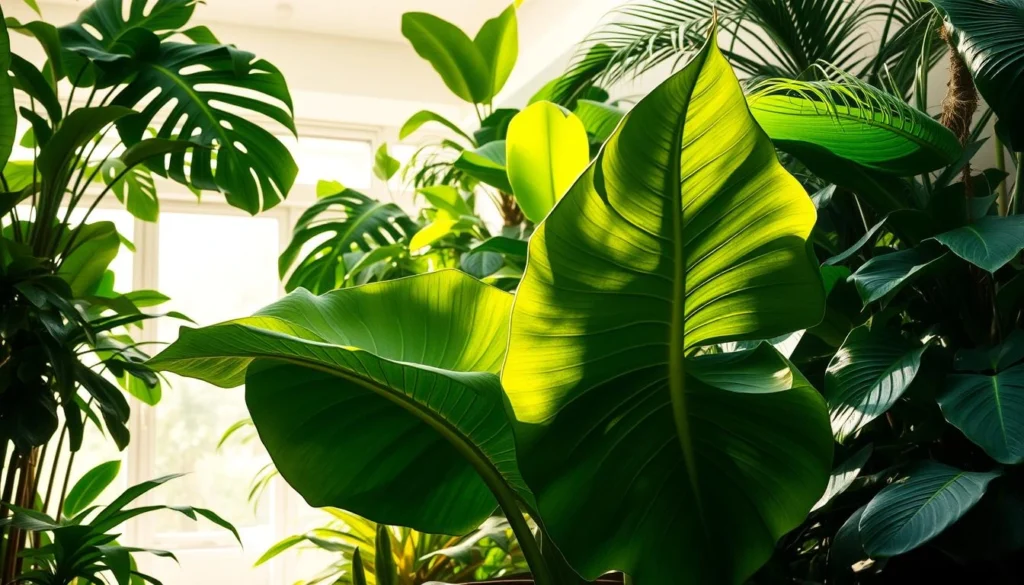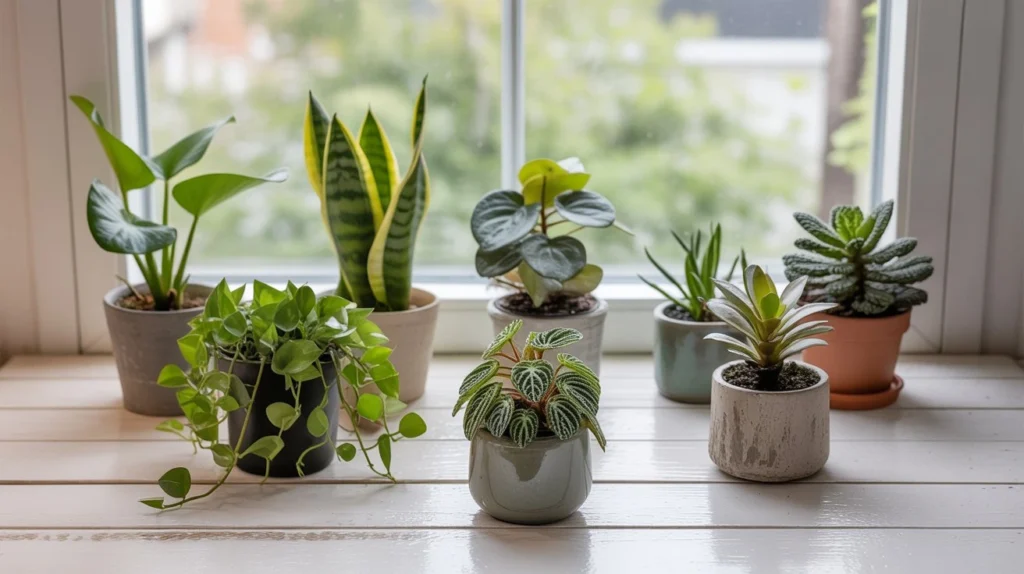
Imagine turning your living space into a lush, tropical oasis. You can make this dream come true with a stylish indoor elephant ear plant. These plants have large, heart-shaped leaves that bring a touch of the exotic to any room.
Adding tropical indoor plants like elephant ear plants to your decor creates a unique atmosphere. They are great for those wanting to add a statement piece to their indoor plant decoration ideas. These plants are elegant and easy to care for.
Table of Contents
The Majestic Indoor Elephant Ear Plant: An Overview
Indoor elephant ear plants add a touch of the tropics to your home. They have large, majestic leaves that make any room stand out. Both Colocasia and Alocasia are great for indoor growing, with Alocasia being more common.

Popular Varieties for Indoor Growing
There are many varieties of elephant ear plants for indoor growing. Some favorites include:
- Alocasia ‘Black Velvet’: Known for its dark, velvety leaves
- Colocasia ‘Elephant Ear’: Features large, heart-shaped leaves
- Alocasia ‘Amazonica’: Boasts striking, silver-veined leaves
These varieties bring unique beauty to your indoor space.
Why These Tropical Beauties Make Stunning Houseplants
Elephant ear plants are perfect for indoor spaces. They can grow well in low light, making them ideal for rooms with little natural light. With the right care, they can grow big and make a bold statement.
Some benefits of having elephant ear plants indoors include:
- Purifying the air
- Adding a touch of the tropics to your decor
- Creating a dramatic focal point in a room
Adding elephant ear plants to your home brings a tropical and vibrant feel.
Essential Indoor Elephant Ear Plant Care Guide
To keep your elephant ear plants thriving indoors, it’s key to know their specific care needs. These tropical beauties need the right conditions for growth.
Light Requirements for Optimal Growth
Elephant ear plants love bright, indirect light. Direct sunlight can burn their big leaves. So, place them near an east- or west-facing window. If using grow lights, make sure they’re not too strong.

Watering and Humidity Needs
Elephant ears prefer moist soil, but don’t like to be waterlogged. Check soil moisture by sticking your finger in up to the first knuckle. If it’s dry, it’s time to water. Keep the air around your plants humid with a humidifier or a tray with water and pebbles.
Temperature and Soil Considerations
Keep your elephant ear plants in a spot with a steady temperature of 65°F to 75°F (18°C to 24°C). Don’t put them near heating or cooling vents. Use a potting mix that drains well to avoid root rot.
Fertilizing for Lush Growth
Feed your elephant ear plants with a balanced, water-soluble fertilizer in spring and summer. Use half the recommended strength to prevent root damage.
| Care Aspect | Recommendation | Tips |
|---|---|---|
| Lighting | Bright, indirect light | Avoid direct sunlight |
| Watering | Maintain moist soil | Check soil moisture regularly |
| Temperature | 65°F to 75°F (18°C to 24°C) | Avoid heating or cooling vents |
| Fertilization | Balanced, water-soluble fertilizer | Dilute to half strength during growing season |
How to Grow Elephant Ear Plants Indoors Successfully
Elephant ear plants can thrive indoors with the right care. They add a touch of elegance to your space. Focus on container selection, planting, and ongoing care to succeed.
Selecting the Right Container and Location
Choosing the right container is key for your elephant ear plant’s health. Pick a pot that’s 2-3 times larger than the plant’s root ball. This gives the roots room to grow. Make sure the container has drainage holes to avoid waterlogged soil.
Place your plant in a bright, indirectly lit area. Avoid direct sunlight to prevent leaf scorch.
Planting and Establishment Tips
Use a potting medium with compost for planting. Spring is the best time to repot elephant ears. This lets the plant grow during the active season.
Water well after planting. Keep the soil moist but not too wet.
Propagation Methods
You can propagate elephant ear plants by division or seed. Division is more common. It involves separating offsets from the mother plant during spring repotting.
Make sure each division has at least one growing eye. This boosts the chances of successful propagation.
Seasonal Care Adjustments
Seasonal changes affect your elephant ear plant’s needs. In spring and summer, keep the humidity high and fertilize often. In fall and winter, water less and stop fertilizing. This lets the plant rest.
By adjusting your care based on the season, you can enjoy a thriving elephant ear plant indoors.
Common Challenges and Troubleshooting
When you care for your elephant ear plants, you might face some common problems. Knowing how to handle these issues is key to keeping your plants healthy. It’s important to be ready for any challenges that might come up.
Identifying and Treating Pest Problems
Elephant ear plants can get pests like spider mites, mealybugs, and scale. Look for white, cottony patches or tiny eggs on the leaves’ underside to spot an infestation. To treat pests, isolate the plant, wash the leaves with mild soap and water, and use insecticidal soap or neem oil if needed.
- Inspect your plants regularly for signs of pests.
- Use insecticidal soap or neem oil to treat infestations.
- Isolate infected plants to prevent the problem from spreading.
Addressing Leaf Yellowing and Other Issues
Yellow leaves can mean you’re watering too much, too little, or not feeding your plants enough. Check your watering and make sure your plants get enough light and food. Elephant ear leaves get dusty, which can harm the plant and lead to disease.
Tips to prevent leaf yellowing:
- Adjust your watering schedule according to the season.
- Fertilize your plants regularly during the growing season.
- Dust the leaves regularly to maintain their health and appearance.
Winter Care Challenges
In winter, elephant ear plants need special care. Water them less because they’re dormant, and keep them away from cold. If it’s too cold outside, bring your plants inside or protect them from frost.
By knowing how to handle these common problems, you can keep your elephant ear plants healthy all year round.
Decorating with Indoor Elephant Ear Plants
Elephant ear plants have big, eye-catching leaves. They can turn any room into a stunning centerpiece. They’re perfect for adding tropical flair to any corner.
Creating Dramatic Focal Points
Make a big statement with elephant ears at your front door or living room. They grab attention and leave a lasting impression. Pick a container that matches the plant’s size and color for the best look.
Pairing with Other Tropical Houseplants
Pair elephant ears with other tropical plants for a lush look. Try them with Philodendron or Dracaena for a lively indoor garden. This mix adds depth and interest to your space.
Small Space Solutions for Large Plants
Even small spaces can have elephant ear plants. Look for compact varieties made for indoor growing. Or use hanging baskets or tiered planters to save space.
| Variety | Light Requirements | Space Needs |
|---|---|---|
| Colocasia | Bright, indirect light | Large containers |
| Alocasia | Low to medium light | Compact spaces |
| Xanthosoma | Medium to bright light | Hanging baskets |
Benefits Beyond Beauty: Why Elephant Ears Deserve a Spot in Your Home
Elephant ear plants are more than just pretty leaves. They bring many benefits to your home. These tropical plants can make your indoor space better in several ways.
Air-Purifying Qualities
One big indoor plant benefit of elephant ear plants is air purification. Like many tropical indoor plants, they clean the air by removing toxins. This makes your home air cleaner and healthier.
Psychological Benefits of Living with Tropical Plants
Having indoor elephant ear plants can also boost your mood. Studies show plants can lower stress, improve mood, and even help your brain. The green leaves of elephant ear plants can make your home feel calm and peaceful.
Creating a Year-Round Vacation Vibe
Adding elephant ear plants to your home can make it feel like a tropical getaway. Their big, exotic leaves bring a sense of calm and tranquility. With the right care, you can enjoy this tropical feel all year round at home.
Read More :
How to Get Rid of Gnats Indoor Plants
Conclusion: Embracing the Tropical Lifestyle with Elephant Ear Plants
Adding an indoor elephant ear plant to your home is a smart move. It turns your space into a tropical oasis. With the right care, these plants can flourish, becoming a stunning centerpiece in any room.
These plants are perfect for adding a tropical touch to your decor. They help create a unique, calming atmosphere. This makes your home feel more relaxing and inviting.
As we’ve discussed, growing elephant ear plants indoors needs careful attention. You must consider their light, water, temperature, and fertilization needs. By following the tips in this article, you can enjoy their many benefits.
These plants purify the air and offer psychological benefits. They can make you feel more relaxed and focused.
So, why not start enjoying the tropical lifestyle today? Elephant ear plants can make your home feel like a tropical paradise all year round. They’re great for adding drama to your decor or simply bringing some greenery into your space.
FAQ
How often should I water my indoor elephant ear plant?
Check the soil by sticking your finger in it. If it’s dry up to an inch, it’s time to water. Water once a week in summer and every 10-14 days in winter. This depends on your home’s humidity and temperature.
What kind of light does an elephant ear plant require?
These plants like bright, indirect light. They can handle low light too. But, direct sunlight can burn their leaves. So, use filtered or dappled light instead.
How do I fertilize my elephant ear plant?
Use a balanced, water-soluble fertilizer in spring and summer. But, dilute it to half strength. This prevents burning the roots.
Why are the leaves of my elephant ear plant turning yellow?
Yellow leaves might mean you’re watering too much or too little. Or, it could be because of extreme temperatures. Check the soil, adjust your watering, and keep the plant in a consistent 65-75°F spot.
Can I grow elephant ear plants in small spaces?
Yes, you can. Choose compact varieties, use a smaller pot, and prune regularly. This keeps the plant small and manageable.
Are elephant ear plants air-purifying?
Yes, they are. Elephant ear plants clean the air by removing toxins. They’re a great choice for indoor spaces.
How do I propagate elephant ear plants?
You can divide the tubers in spring or take stem cuttings. Make sure the new plants get bright, indirect light and consistent moisture.
Can I grow elephant ear plants outdoors?
Yes, in warm climates (USDA zones 9-11), you can grow them outside. In cooler areas, grow them in containers and move them indoors during winter.

